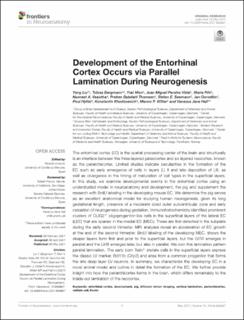| dc.contributor.author | Liu, Yong | |
| dc.contributor.author | Bergmann, Tobias | |
| dc.contributor.author | Mori, Yuki | |
| dc.contributor.author | Vidal, Juan Miguel Peralvo | |
| dc.contributor.author | Pihl, Maria | |
| dc.contributor.author | Vasistha, Navneet A. | |
| dc.contributor.author | Thomsen, Preben Dybdahl | |
| dc.contributor.author | Seemann, Stefan E. | |
| dc.contributor.author | Gorodkin, Jan | |
| dc.contributor.author | Hyttel, Poul | |
| dc.contributor.author | Khodosevich, Konstantin | |
| dc.contributor.author | Witter, Menno | |
| dc.contributor.author | Hall, Vanessa Jane | |
| dc.date.accessioned | 2021-06-11T07:55:02Z | |
| dc.date.available | 2021-06-11T07:55:02Z | |
| dc.date.created | 2021-06-10T15:54:28Z | |
| dc.date.issued | 2021 | |
| dc.identifier.citation | Frontiers in Neuroanatomy. 2021, 15, . | en_US |
| dc.identifier.issn | 1662-5129 | |
| dc.identifier.uri | https://hdl.handle.net/11250/2758925 | |
| dc.description.abstract | The entorhinal cortex (EC) is the spatial processing center of the brain and structurally is an interface between the three layered paleocortex and six layered neocortex, known as the periarchicortex. Limited studies indicate peculiarities in the formation of the EC such as early emergence of cells in layers (L) II and late deposition of LIII, as well as divergence in the timing of maturation of cell types in the superficial layers. In this study, we examine developmental events in the entorhinal cortex using an understudied model in neuroanatomy and development, the pig and supplement the research with BrdU labeling in the developing mouse EC. We determine the pig serves as an excellent anatomical model for studying human neurogenesis, given its long gestational length, presence of a moderate sized outer subventricular zone and early cessation of neurogenesis during gestation. Immunohistochemistry identified prominent clusters of OLIG2+ oligoprogenitor-like cells in the superficial layers of the lateral EC (LEC) that are sparser in the medial EC (MEC). These are first detected in the subplate during the early second trimester. MRI analyses reveal an acceleration of EC growth at the end of the second trimester. BrdU labeling of the developing MEC, shows the deeper layers form first and prior to the superficial layers, but the LV/VI emerges in parallel and the LII/III emerges later, but also in parallel. We coin this lamination pattern parallel lamination. The early born Reln+ stellate cells in the superficial layers express the classic LV marker, Bcl11b (Ctip2) and arise from a common progenitor that forms the late deep layer LV neurons. In summary, we characterize the developing EC in a novel animal model and outline in detail the formation of the EC. We further provide insight into how the periarchicortex forms in the brain, which differs remarkably to the inside-out lamination of the neocortex. | en_US |
| dc.language.iso | eng | en_US |
| dc.publisher | Frontiers Media | en_US |
| dc.rights | Navngivelse 4.0 Internasjonal | * |
| dc.rights.uri | http://creativecommons.org/licenses/by/4.0/deed.no | * |
| dc.title | Development of the Entorhinal Cortex Occurs via Parallel Lamination During Neurogenesis | en_US |
| dc.type | Peer reviewed | en_US |
| dc.type | Journal article | en_US |
| dc.description.version | publishedVersion | en_US |
| dc.source.volume | 15 | en_US |
| dc.source.journal | Frontiers in Neuroanatomy | en_US |
| dc.identifier.doi | 10.3389/fnana.2021.663667 | |
| dc.identifier.cristin | 1915123 | |
| dc.description.localcode | Copyright © 2021 Liu, Bergmann, Mori, Peralvo Vidal, Pihl, Vasistha, Thomsen, Seemann, Gorodkin, Hyttel, Khodosevich, Witter and Hall. This is an open-access article distributed under the terms of the Creative Commons Attribution License (CC BY). The use, distribution or reproduction in other forums is permitted, provided the original author(s) and the copyright owner(s) are credited and that the original publication in this journal is cited, in accordance with accepted academic practice. No use, distribution or reproduction is permitted which does not comply with these terms. | en_US |
| dc.source.articlenumber | 663667 | en_US |
| cristin.ispublished | true | |
| cristin.fulltext | original | |
| cristin.qualitycode | 1 | |

